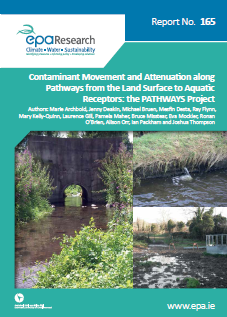Authors: Marie Archbold, Jenny Deakin, Michael Bruen, Mesfin Desta, Ray Flynn, Mary Kelly- Quinn, Laurence Gill, Pamela Maher, Bruce Misstear, Eva Mockler, Ronan O’Brien, Alison Orr, Ian Packham and Joshua Thompson
Summary: The synthesis report for the PATHWAYS project.

In order for Ireland to meet its obligations under the Water Framework Directive (WFD) we need to understand how diffuse nutrients reach water bodies and impact on Irish aquatic ecosystems. By combining information on hydrological and hydrogeological pathways with land use pressures, a conceptual understanding was developed in the Irish context which provides a basis for assessing the impacts of land use on water quality. This knowledge provides a foundation for identifying the areas in Irish catchments that contribute the greatest proportion of nutrients to water bodies (receptors). These areas are referred to as critical source areas. Locating critical sources areas helps ensure that appropriate management strategies are targeted to maintain and/or improve water quality by (1) reducing the nutrient loading in critical source area and/or (2) breaking the pathways linkage between thecritical source area and the receptor. Understanding the transport pathways linking the diffuse nutrients source tothe receptor is vital in determining the most appropriate management strategies/mitigation measures.
Findings from the PATHWAYS Project have informed the Environmental Protection Agency’s WFD characterisation approach with both surface and subsurface pathways considered in the risk assessment process. The findings have also permitted the development of a suite of catchment management support tools to assist environmental/waterresources/catchment managers in defining critical source areas for diffuse contaminants and assessing appropriate measures for protection and/or improvement of water quality. Outputs from the catchment management support tool include a national suite of pollution impact potential (PIP) maps that delineate critical source areas fornutrients (PO4 and NO3) and these maps have been refined since the completion of the Pathways Project for use bythe EPA and local authorities in catchment management.
Follow this link to view the associated project documentation on SAFER
https://www.epa.ie/media/epa-2020/publications/research/165_web_image[1].png